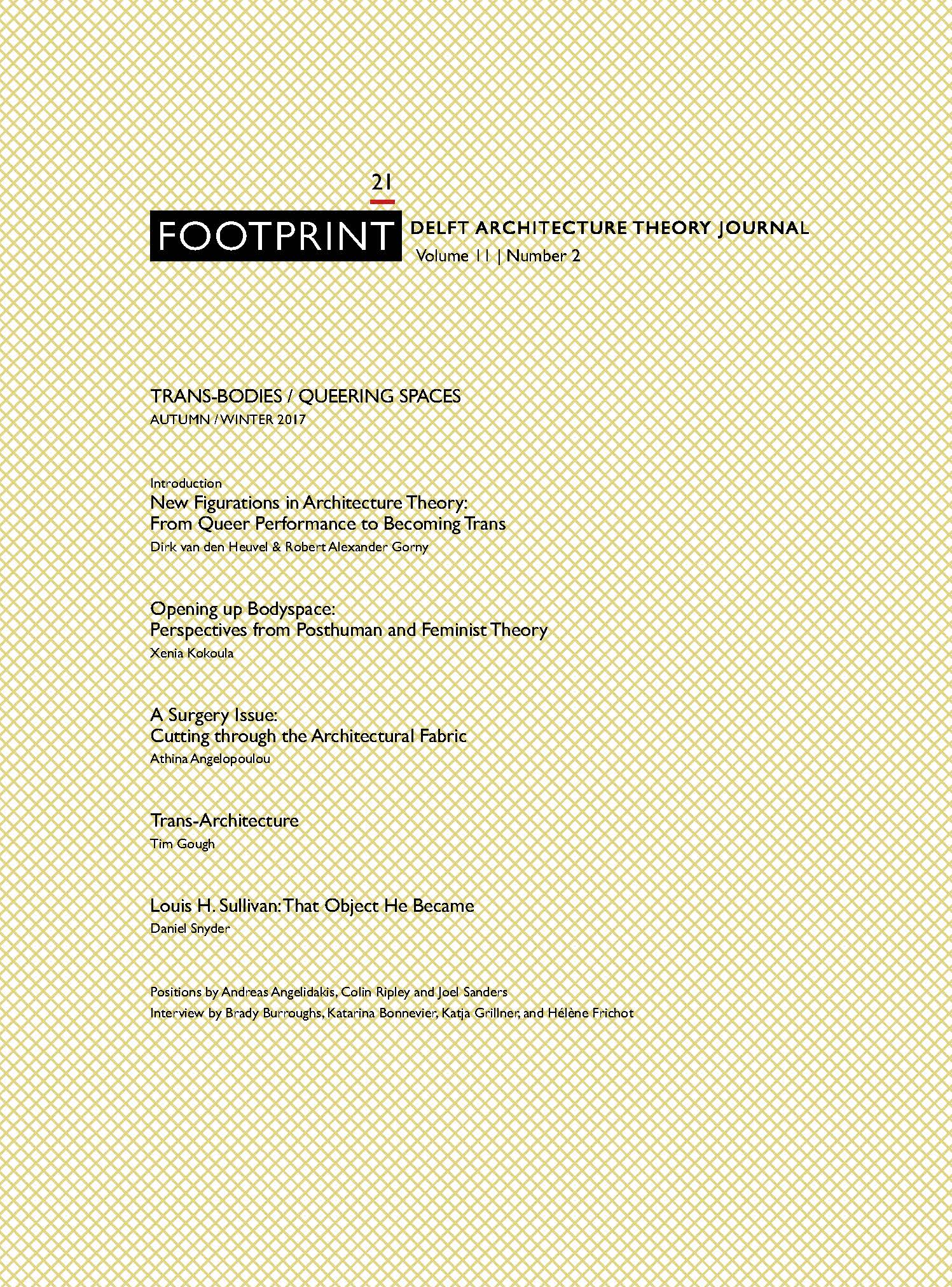Opening up Bodyspace: Perspectives from Posthuman and Feminist Theory
DOI:
https://doi.org/10.7480/footprint.11.2.1898Abstract
A rethinking of space, a rethinking of the body and a rethinking of a design processes involving both are long overdue within space-related disciplines. Over the last decades, architectural discourse has been invigorated by opening up container conceptions of space, by exploring a new dynamic understanding of space and focusing on its production processes. But a systematic, theoretically-informed understanding of the body along the same terms has yet to be achieved. Such a search for new visions and concepts of corporealities can start at different places. This essay attempts a cross-disciplinary, speculative foray into the terrain of posthuman, nonhuman and feminist theory. From this diverse body of scholarship it is possible to develop theses for open, permeable and inextricably entangled bodies inhabiting an equally dynamic space. These theses are examined not only within their own disciplinary discourses but also as aesthetic categories and spatial organisation principles aimed at tentatively exploring the implications for space-related disciplines including architecture and design.
References
Ahmed, Sara. ‘Affective Economies’. Social Text, 79, vol. 22, no. 2 (2004): 117–39.
Ahmed, Sara. The Cultural Politics of Emotion. New York: Routledge, 2004.
Arendt, Hannah. The Human Condition. Chicago: The University of Chicago Press, 1958.
Bakhtin, Mikhail. Rabelais and His World. Bloomington: Indiana University Press, 1984.
Barad, Karen. Meeting the Universe Halfway: Quantum Physics and the Entanglement of Matter and Meaning. Durham, NC: Duke University Press, 2007.
Brown, Lorie A. Feminist Practices: Interdisciplinary Approaches to Women in Architecture. New York and London: Routledge, 2011.
Butler, Judith. Notes Toward a Performative Theory of Assembly. Cambridge, MA: Harvard University Press, 2015.
Colomina, Beatriz, and Mark Wigley, Are we Human? Notes on an Archeology of Design. Zurich: Lars Müller Publishers, 2016).
De Cauter, Lieven. ‘The Capsule and the Network: Preliminary Notes for a General Theory’. OASE Journal for Architecture 54 (2001): 122–34.
Dereix Carrillo, Catherine. ‘The Body as Dust’. Journal of Landscape Architecture 11, no. 3 (2016): 32–45.
Diller, Elisabeth. ‘Bad Press’. In Gender Space Architecture: An Interdisciplinary Introduction, edited by Iain Borden. London: Routledge, 2000.
Frank, Susanne. Stadtplanung im Geschlechterkampf: Stadt und Geschlecht in der Großstadtentwicklung des 19. und 20. Jahrhunderts. Wiesbaden: Springer, 2003.
Gould, Peter. ‘Space and Rum: An English Note in Espacien and Rumian Meaning’. Geografiska Annaler 63, no. 1 (1981): 1–3.
Gregory, Derek. ‘Tahrir: Politics, Publics and Performances of Space’. Middle East Critique 22, no. 3 (2013): 235–46.
Grosz, Elizabeth. ‘Bodies-Cities’. In Sexuality & Space (proceedings of a symposium held at Princeton University School of Architecture, 10–11 March 1990), edited by Beatriz Colomina and Jennifer Bloomer. New York: Princeton Architectural Press, 1996.
Grosz, Elizabeth. Architecture from the Outside: Essays on Virtual and Real Space. Cambridge, MA: MIT Press, 2001.
Grusin, Richard (ed.). The Nonhuman Turn. Minneapolis: University of Minnesota Press, 2015.
Harrison, Ariane Lourie (ed.). Architectural Theories of the Environment: Posthuman Territory. New York: Routledge, 2013.
Kuhlmann, Dörte. Gender Studies in Architecture: Space, Power and Difference. London and New York: Routledge, 2013.
Landesman, Tucker J. ‘Review: Judith Butler, Notes Toward a Performative Theory of Assembly’. In Antipode: A Radical Journal of Geography (2015). Available online at https://radicalantipode.files.wordpress.com/2016/02/book-review_landesman-on-butler.pdf.
Leach, Neil. Rethinking Architecture: A Reader in Cultural Theory. London: Routledge, 1997.
Lefebvre, Henri. The Production of Space. Malden, MA: Blackwell, 2011.
Löw, Martina. ‘Der Körperraum Als Soziale Konstruktion’. In Geschlechter-Räume: Konstruktionen
von ‘gender’ in Geschichte, Literatur und Alltag, edited by Margarete Hubrath. Cologne: Böhlau, 2001.
Löw, Martina. ‘The Constitution of Space: The Structuration of Spaces through the Simultaneity of Effect and Perception’. European Journal of Social Theory 11, no. 1 (2008): 25–49. doi:10.1177/1368431007085286.
Löw, Martina. ‘The Social Construction of Space and Gender’, European Journal of Women’s Studies 13, no. 2 (2006): 119–33. doi:10.1177/1350506806062751.
Löw, Martina. Raumsoziologie. Frankfurt am Main: Suhrkamp, 2012.
Löw, Martina. The Sociology of Space: Materiality, Social Structures, and Action, translated by Donald Goodwin. New York: Palgrave Macmillan, 2017 [2001] .
Martin, Katharina D. ‘Ecologies of Corporeal Space’. In Critical and Clinical Cartographies: International Conference Proceedings, edited by Andrej Radman and Stavros Kousoulas. Delft: Japsam Books and TU Delft, 2015).
Morton, Timothy. ‘Queer Ecology’. Publications of the Modern Language Association of America 125, no. 2 (March 2010): 277.
Morton, Timothy. ‘Zero Landscapes in the Time of Hyperobjects’. GAM Graz Architecture Magazine 07 (2011): 79–87.
Morton, Timothy. Ecology Without Nature: Rethinking Environmental Aesthetics. Cambridge, MA: Harvard University Press, 2007.
Morton, Timothy. Hyperobjects: Philosophy and Ecology after the End of the World. Minneapolis: University of Minnesota Press, 2013.
Puar, Jasbir. Terrorist Assemblages: Homonationalism in Queer Times. Durham, NC: Duke University Press, 2007.
Renn, Jürgen, and Bernd Scherer. Das Anthropozän: Zum Stand der Dinge. Berlin: Matthes & Seitz, 2015.
Saldanha, Arun. ‘Reontologising Race: The Machinic Geography of Phenotype’. Environment and Planning D: Society and Space 24 (2006): 9–24.
Schroer, Markus. Räume, Orte, Grenzen: Auf dem Weg zu einer Soziologie des Raums. Frankfurt am Main: Suhrkamp, 2006.
Simonsen, Kirsten. ‘Bodies, Sensations, Space and Time: The Contribution from Henri Lefebvre’. Geografiska Annaler 87, no. B (2005): 1–14.
Teyssot, Georges, ‘Soft Architecture and the Spaces of Topology’. In Could Should Would, edited by Wilko Hoffman. Ostfildern: Hatje Cantz, 2015.
Teyssot, Georges. ‘The Mutant Body of Architecture’. In Flesh: Architectural Probes, edited by Elizabeth Diller and Ricardo Miller Scofidio, 8–35. New York: Princeton Architectural Press, 1994. 8–35.
Van Berkel, Ben, and Caroline Bos. Move 2: Techniques, Network Spin (1999).
Downloads
Published
Issue
Section
License
- Authors retain copyright and grant the journal right of first publication with the work simultaneously licensed under a Creative Commons Attribution License that allows others to share the work with an acknowledgement of the work's authorship and initial publication in this journal.
- Authors are able to enter into separate, additional contractual arrangements for the non-exclusive distribution of the journal's published version of the work (e.g., post it to an institutional repository or publish it in a book), with an acknowledgement of its initial publication in this journal.





